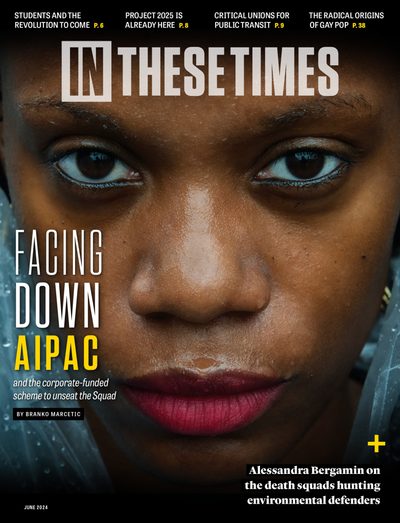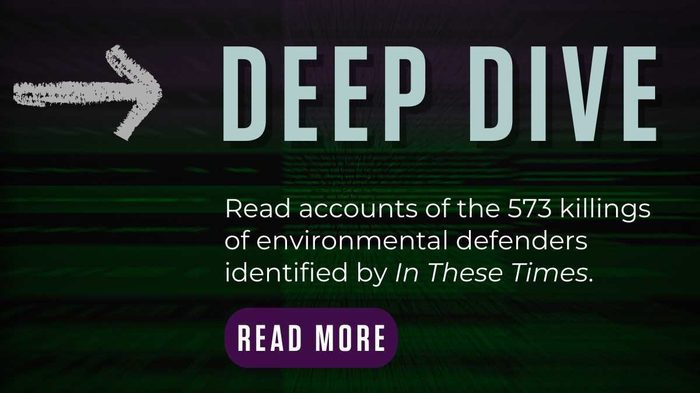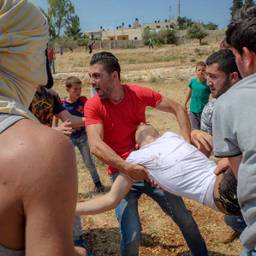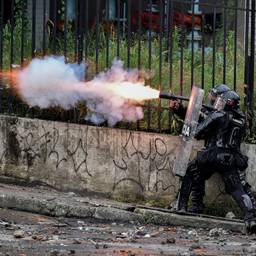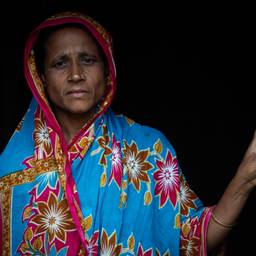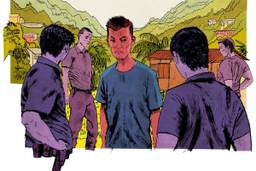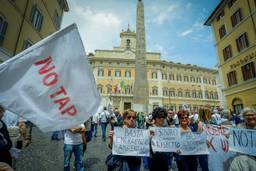The Death Squads Hunting Environmental Defenders
Around the world, government forces regularly attack environmental activists with impunity—and U.S. support.
Alessandra Bergamin Illustrations by Matt Rota
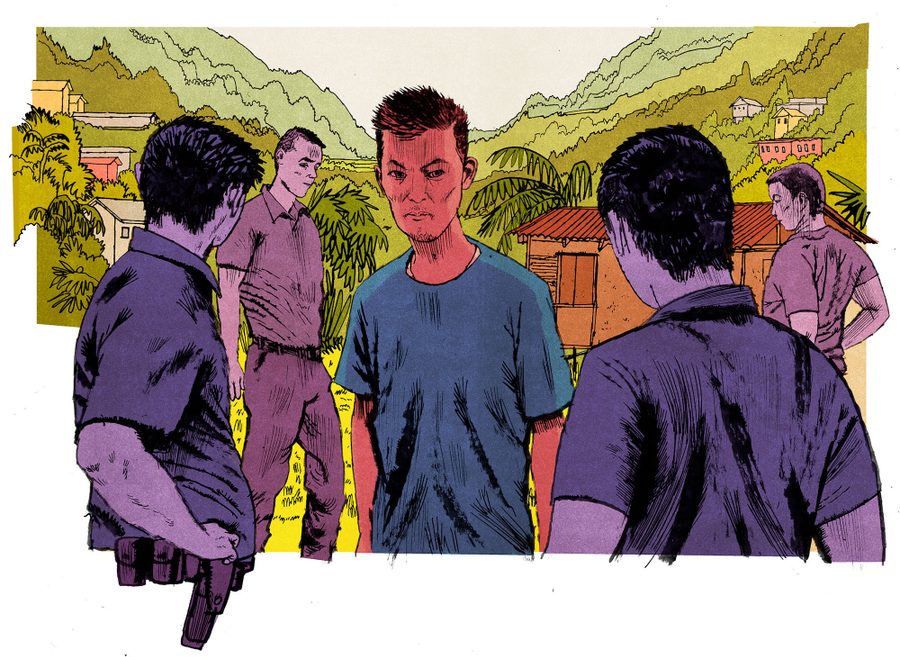
Lea este artículo en Español.
Before the day’s light had begun to dim, Brandon Lee picked up his phone and texted Sister Genny. “Even until now,” he told the nun, “I feel like I’m being watched.”
It was Tuesday, August 6, 2019, and the habagat season was pulling tropical storms across the mountains of the Cordillera, the rural interior of the Philippine island of Luzon. In Lee’s home province of Ifugao, the threat of a deluge had passed, leaving behind leaden skies and the sticky heat of the wet season. For a week, after a fraught decision made with his wife, Bernice, Lee had hardly left their home in the municipality of Lagawe. He no longer went to work at the office down the road, no longer walked his niece and daughter to school, no longer went anywhere on foot.
As Lee texted Sister Genny, he reheated chicken and rice, sharing the meal with his 7-year-old daughter, Jesse Jane. At around 5:45 p.m., Lee stepped outside to feed his dogs. As he scraped meat from the leftover chicken bones, he heard a thunderous crack. His body crumpled. A deafening buzz filled his ears. Then Jesse was outside, screaming.
Until that day, Lee, a Chinese-American activist from the San Francisco Bay Area, had called the Cordillera home for nearly a decade. It was where he fell in love, married Bernice and started a family. It was also where he became involved with the Ifugao Peasant Movement (IPM), an alliance of groups organizing local farmers and indigenous people against corporations that occupied and stripped resources from their ancestral land.
The Philippines is among the world’s most mineral-rich countries. Since the passage of a 1995 law allowing 100% foreign ownership of land, the Philippine government has prioritized mining and development companies over its people and the environment. The Cordillera, with its undulating mountains, terraced rice fields and valley-carving rivers, is full of minerals to be mined and waterways to be harnessed. And as deep-pocketed corporations desiccate rivers and destroy peasant livelihoods in a nationwide plunder supported by the state, it’s also a place where human rights are abused with impunity.
In Ifugao, that had already meant the killing of two indigenous IPM leaders in four years: William Bugatti in 2014 and Ricardo Mayumi in 2018. Both had been involved in human rights and environmental organizing, including, for Mayumi, fighting a hydropower project that would dam the rivers, displace communities and impede locals’ ability to grow rice. Both had received death threats, and in both cases, their assailants were never found. But Philippine activists recognized familiar signs that suggest the military was involved.
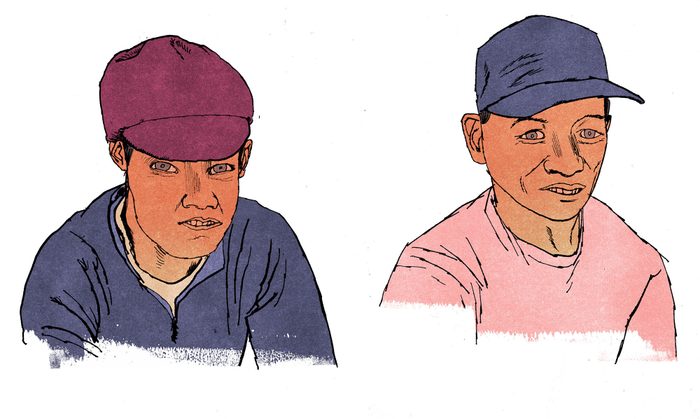
When Lee, who’d been living elsewhere on Luzon, attended Bugatti’s 2014 funeral, his IPM comrades asked him to move back to Lagawe and continue the activist’s work. But Lee’s return marked the beginning of heightened surveillance and harassment of IPM by members of the 54th Infantry Battalion — one of numerous Philippine armed forces units that have received U.S. funding and support. In late July 2019, Lee said, a battalion leader visited his home and office, knocking relentlessly while he hid quietly inside. A week later, Lee was shot in his own backyard.
As Jesse ran back inside, blood pooled around Lee’s collapsed body. He could move his head, eyes and mouth, but it was getting hard to speak. When his brother-in-law arrived, Lee had to sound out each letter of his wife’s name, asking him to call Bernice. They rushed first to a small local hospital, then to a regional hospital an hour away. Neither could help; Lee needed a hospital three and a half hours farther. Somewhere amid the peaks and drops of the narrow mountain roads, the ambulance broke down. Then Lee ran out of oxygen and began vomiting blood.
Bernice caught up with the ambulance, and Lee, thinking of his daughter’s scream, apologized again and again.
When they finally arrived at Baguio General Hospital, some six hours later, medical staff asked Lee what had happened. He hadn’t seen the gun or the person aiming it. But in his last conscious moments, Lee told them what he felt certain was true: “It was the military.”
Between 2012 and 2022, around the world, one environmental defender was killed every other day, according to international human rights group Global Witness. That’s nearly 2,000 peasants, farmers, fisherfolk and activists murdered for defending their land from some of the biggest contributors of greenhouse gas emissions — including mining, logging and agribusiness corporations — as well as hydropower projects, which have their own ruinous environmental impact.
In this harrowing toll, indigenous peoples face significantly disproportionate rates of violence, since they are nearly always on the front lines.
Indigenous territories protect about 80% of the world’s biodiversity, including lands, rivers, oceans and forests that act as important carbon sinks. But their land is also the focus of intense extractive industry speculation. While the United States has signed international environmental treaties like the Paris Agreement or 30×30 (a biodiversity plan to protect 30% of natural spaces by 2030), the ability to mitigate the effects of climate change ultimately hinges on the protection of environmental defenders, who face surveillance, intimidation, false charges and, increasingly, forcible disappearance. Some communities — mostly rural areas near extractive projects — face indiscriminate bombing campaigns. As it was in the Cordillera — where bombings preceded the shootings of Bugatti, Mayumi and Lee — these attacks often presage greater violence. Bodies, sometimes mutilated or showing evidence of torture, are found in ravines, plastic drums and mass graves. No one is found guilty but signs often point to corporations, organized crime and non-state armed groups.
The state, too, is frequently complicit — particularly in countries that label environmental defenders as “terrorists,” which casts extrajudicial killings as matters of national security.
In These Times tracked violence against environmental defenders from 2014 to 2024 in 10 hotspot countries. Using the same methodology as a State Department watchdog group, we collected data from public sources to conservatively identify 573 killings of environmental activists. Of that number, close to half involved the state.
In Brazil, 24 of 53 cases were connected to the police or military, including a 2017 massacre of activists participating in a land occupation. In India, police were involved in 40 out of 44 killings over the past decade, many during demonstrations against mining projects or land grabs. In Peru, police were responsible for 13 of 18 killings, most often activists protesting extractive industry projects.
In Guatemala, indigenous defenders protesting a mining company in 2021 faced attacks from police, military and intelligence officers. Tear gas was used, homes set ablaze. In Brazil, some police work for the government by day and as private security for extractive companies by night.
Powerful companies tell governments, “we need your protection,” says Michel Forst, the first United Nations Special Rapporteur on Environmental Defenders, whose position was created in 2022 to address increasing attacks on activists. “And, of course, the government will protect the interests of the companies.”
The Philippines is considered the most dangerous country for environmental defenders in Asia, with attacks dating back to the 1980 murder of Macli-ing Dulag, an indigenous Kalinga man from the Cordillera who was killed by the military while protesting a hydropower project. A very conservative assessment suggests evidence of state involvement in 109 of 210 such killings in the Philippines in the past decade — more than half.
In 2017, eight indigenous defenders from the Lumad people were killed by the 27th Infantry Battalion after protesting the expansion of a coffee plantation on their ancestral land. The violence was so brutal that one woman had to place part of her husband’s brain back into his skull to prepare him for burial.
In 2020, on Panay Island, nine indigenous Tumandok leaders, also fighting a hydropower project, were kidnapped, tortured and killed on the same night, in a synchronized military and police operation. The massacre silenced a community and cleared the path for a megadam.
In 2023, farmers Aimee and Jover Villegas were allegedly killed by members of the Civilian Armed Forces Geographical Unit, a paramilitary force trained and funded by the government. In a country where farmers and indigenous people are often automatically considered environmental activists — because subsistence farming inherently places them at odds with corporate or extractive interests — Aimee’s throat was slashed and breast stabbed, and Jover’s left eye was gouged: a map of the torture they endured before being killed.
The hidden nature of the killings and the entanglement of military, paramilitary and local police makes it hard enough to trace state complicity, let alone track them back to more powerful geopolitical actors — such as the neocolonial U.S. military apparatus that has long cleared the way for resource extraction, and the global corporate and financial interests that ultimately profit. Yet, in many states — including the Philippines and much of Latin America — the wars on terror and drugs under which these executions are carried out are extensions of U.S. hegemony and conducted with U.S. weapons and training.
While the State Department condemns such killings — and, in 2017, even formed an interagency working group to monitor and address violence against environmental defenders — in practice, the United States has almost never had to take accountability for the local killings of activists by the governments it supports.
But when a U.S. citizen like Brandon Lee is shot, the public begins following the path back to America to look for answers.
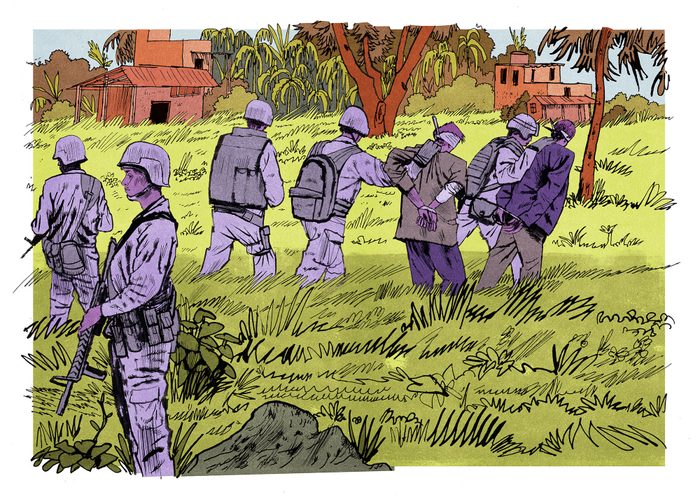
The intimidation began in 2015, when Lee returned to Lagawe to take up Bugatti’s work assisting the defense of political prisoners. That April, 11 members of IPM were sent brown envelopes with the words, “Gray May, June gloom, No Sky July,” as well as a photo of a traditional Ifugao funeral blanket. Intricately woven with red, white and dark stripes, the blanket was an implicit death threat: should they continue Bugatti’s work, they would meet the same fate.
Around the same time, Lee and IPM began organizing against a newly contracted dam project, the Alimit Hydropower Complex, which would straddle the Ibulao and Alimit rivers. The project is owned and operated by SN Aboitiz Power — a partnership between a Norwegian energy company and Aboitiz Power, the private corporation of an oligarchic Philippine family friendly with former and current Philippine presidents.
While Europe and North America are tearing down rather than building dams, the hydropower industry is booming across the developing world. Often touted as a form of renewable energy, hydropower functions in much the same way as extractive industries, replicating not only the environmental casualties — such as deforestation and loss of biodiversity — but also the human toll. Communities are displaced, farmland is submerged, subsistence fisheries are destroyed, water sources are choked and resistance is met with intimidation and violence. In the Philippines, other SN Aboitiz Power megadams had already eaten away vast swaths of land, rivers and rice fields once held by indigenous people and farmers.
In an email statement, SN Aboitiz Power maintained that they follow local and international social and environmental standards, are committed to a transparent and inclusive process and welcome opposing perspectives. The company was made aware of the attacks on Mayumi and Lee through news reports, stating, “SN Aboitiz Power deplores any form of violence and harassment.”
In Ifugao, as Alimit’s approval process began, familiar patterns emerged. Aboitiz solicited the rights to indigenous peoples’ ancestral lands. Those who protested found themselves “red-tagged” — publicly declared terrorists. Once or twice a week, photos of IPM members, including Lee, were posted on social media pages popular in Ifugao, linking the activists with the New People’s Army (NPA), the armed branch of the Communist Party of the Philippines. A Maoist insurgency group, the NPA is known to engage in armed encounters with the Philippine military, attack extractive industry infrastructure and mete out its own form of justice against “counterrevolutionaries,” often civilians. But the “NPA” label has also become a means for the government to discredit activists, whether they’re connected to the insurgency group or not. Two years before William Bugatti’s 2014 murder, his name was included on a military list of supposed NPA members, although Lee and other activists say he was never involved with the insurgency group.
By 2018, the red-tagging was escalating. Flyers were distributed across Lagawe listing the names of IPM members, including Lee, and the phrase “accomplices of the terrorist NPA in Ifugao.” In response, the IPM issued a statement signed by local political representatives and organizations, condemning the accusations as “malicious lies.”
While the flyers were anonymous, the consensus among Philippine activists and outside groups such as Human Rights Watch is that most, if not all, red-tagging is connected to the state. The practice, often a prelude to violence, not only discredits activists but dismantles entire movements and erodes solidarity among organizers and affected communities. Military battalions and divisions have also posted images on social media purportedly mapping connections between local activists and the NPA through a series of lines and arrows, akin to a police evidence board. (On Facebook, the 54th Battalion has consistently maintained that their labeling of activists as NPA members does not amount to red-tagging, even using the hashtag #ThereIsNoRedTagging.)
“Any organization is a terrorist now,” reflected a former IPM leader, Dick, who was red-tagged alongside Lee (and who requested to use only his first name out of concern of being targeted again).
Amid the heightened harassment, in March 2018, IPM member Ricardo Mayumi — who’d led the opposition to another Ifugao hydropower project, and who’d also been falsely linked to NPA — was shot and killed outside his home. The Philippine-based Indigenous Peoples Movement for Self-Determination and Liberation charged that the Civilian Armed Forces Geographical Unit — the same government-affiliated paramilitary allegedly involved in the killings of the Villegas family — was behind the assassination.
That same year, President Rodrigo Duterte — then waging his bloodthirsty “war on drugs,” which led to at least 2,555 police-related killings—formed an anti-Communist task force that terminated peace talks with the NPA and inaugurated a new campaign of intimidation and violence. As one UN special rapporteur concluded, much of the task force’s work amounted to “persecution of environmental human rights defenders.”
By 2019, another UN special rapporteur — Victoria Tauli-Corpuz, whose focus was indigenous peoples’ rights—was red-tagged herself, as the Philippine Department of Justice included her on a list of more than 600 people the Duterte government hoped to declare terrorists. Tauli-Corpuz is from the Cordillera, where her brother, Steve Tauli, has been organizing against a hydropower project.
In Lagawe, Lee and the IPM began to face direct harassment. In April 2019, 54th Infantry Battalion Sgt. Joel Campilis and another high-ranking officer visited IPM’s office, telling Lee they wanted to “partner” with the organization — which Lee and his colleagues interpreted as a demand to provide information on those involved in the movement. Lee demurred, citing a recent massacre on the island of Negros Oriental, where Philippine National Police killed 14 small-scale farmers after branding them terrorists for advocating for peasants’ rights. The following month, other officers from the battalion returned to the office, asking Lee’s colleagues about his whereabouts, finances and where his daughter attended school.
Then came the day late that July, when military officers visited Lee’s home and then office, knocking for half an hour while Lee and a student refused to answer. When it seemed they had left, Lee went outside and saw four people hiding behind a nearby shed. Dressed in a mix of plain clothes and army fatigues but no name tags, they said they represented the 54th Battalion. One officer took photos of Lee on his phone. Another again pressed him to work with their unit.
“I will give you two names and you can tell your boss why we are reluctant to partner with you,” Lee said. “William Bugatti and Ricardo Mayumi. Your boss should understand why.”
After that, Lee stopped going to the office and laid low. A week later, three IPM members were visited by military and police, all on the same day, with at least one asked about his relationship with Lee. It was the day Lee was shot.
In the days after he was rushed to Baguio General Hospital, doctors attempted to remove the bullet fragments lodged inside his body, although they couldn’t determine whether one bullet had splintered or four had torn through his spine, shoulder, face and arm. During the operation, Lee went into his first cardiac arrest. After seven additional cardiac arrests, Lee’s family and friends were warned he might not survive another. In the intensive care unit, Lee, so consumed by pain he couldn’t hold his wife’s hand, told Bernice, “I’m ready to go now.”
Lee’s condition slowly stabilized, but he remained in the ICU for roughly a month. According to a human rights report, during that time, three police officers, ostensibly providing security, were stationed by the hospital’s entrance 24 hours per day. Lee’s family and friends responded with their own round-the-clock vigil by his bedside, worried someone might try to finish the job.
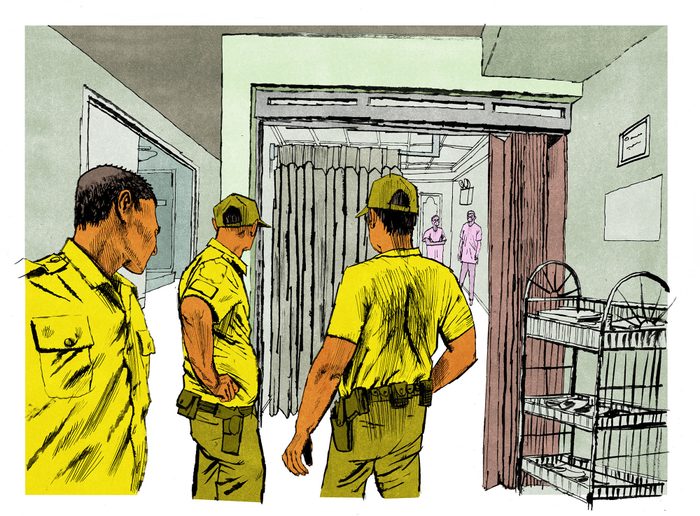
The police investigation had given them little grounds for trust. They told Lee’s family that the 54th Battalion was not a suspect and someone from IPM was likely responsible instead — a claim Bernice found absurd. As far as she and Lee knew, he had no enemies but the state.
As international scrutiny grew, the government’s story changed repeatedly. Immediately after Lee was shot, 54th Infantry Battalion Commander Narciso B. Nabulneg Jr. told a government-owned TV station that his battalion had determined the IPM was part of NPA’s insurgency in Ifugao. Roughly a week later, a government press release claimed Lee had a “harmonious relationship” with the unit, with Sgt. Campilis claiming Lee had “willingly entertained government forces at the IPM office.” That press release was subsequently scrubbed from the state website. Later still, statements from a National Police leader charged that Lee was personally an NPA member and that U.S.-Philippine solidarity groups operate as recruitment fronts.
But the sort of concrete evidence that could have connected the military to the shooting remained out of reach. While a police investigator sought to retrieve the bullets from the attack, doctors had determined that removing them would be too risky after Lee’s repeated cardiac arrests. So they remained lodged within Lee’s body, serving as a constant reminder of what he sees as governmental complicity in the attempt on his life — complicity that begins with the Philippine armed forces and ends thousands of miles away.
“It’s a reminder of what the U.S. is doing to activists around the world,” Lee says. “And which side they are supporting.”
The 10 hotspot countries that In These Times examined — in which close to half of environmental defender murders can be traced to the state — are also countries that received substantial equipment, training and weaponry from the United States for warfare, counterterrorism and counternarcotics operations. Many are in Latin America, where U.S. postcolonial history has involved both intensive resource extraction and military campaigns — which have sometimes been intertwined. Between 2014 and 2022, the last year for which data is available, the U.S. collectively sent these countries more than $4 billion in security assistance.
A number of instances of confirmed human rights abuses against defenders have been linked to that assistance.
In Honduras, three U.S.-trained former Honduran military officers were involved in the 2016 assassination of Berta Cáceres, an indigenous Lenca activist who was fighting a hydropower project. (One, former intelligence officer Roberto David Castillo Mejía, was later convicted of ordering and planning the attack.)
In Colombia, Latin America’s largest recipient of U.S. security assistance, the human rights group Washington Office on Latin America documented several instances of military and police threatening and harassing activists participating in the 2021 national strike, including a contingent of protesters who blocked access to an oil and gas field to protest the harm inflicted by extractive industries. Afterward, 55 members of Congress sent a letter to Secretary of State Antony Blinken calling for the suspension of security assistance to Colombia’s police.
The same year, six members of Congress wrote Blinken about allegations that jeeps the Department of Defense provided to Guatemala were used to harass indigenous activists protesting a mining company in El Estor. The U.S. Government Accountability Office documented several more instances of equipment misuse in Guatemala, flagging the troubling fact that the departments of State and Defense have no policy to investigate such cases.
The Philippines traces its military relationship with America back to nearly 50 years of U.S. occupation. Although the United States withdrew in 1946, the Philippines was still dependent on the U.S. Armed Forces for weapons and equipment. In 1980, when indigenous environmental activist Macli-ing Dulag was shot, the bullets at the scene were traced back to an American-made, WWI-era Browning automatic rifle.
“The Philippine military was designed by the U.S. from the beginning, from colonization,” says Rev. Luisito Saliendra, a human rights defender based in Southern Tagalog, where police and military killed nine activists in the March 7, 2021, “Bloody Sunday” massacre. “I know nothing of any military that is fully designed for Filipinos.”
Today, the Philippines is the largest recipient of U.S. security assistance in the Indo-Pacific region. From 2015 to 2022, the country received $1.14 billion worth of arms, equipment and training, including $475.3 million in foreign military financing, whereby Congress appropriates money to help other governments make military purchases.
As the shells and bullets from Lee’s attack have either disappeared or remain embedded in his body, any direct evidence linking the United States back to his assailants is harder to trace.
Complicating matters, public data on U.S. arms sales and military aid sent around the world each year is either unavailable, unclear or undetailed. Most arms transfers are functionally untraceable, since the weapons are transferred to a central government agency, rather than directly to a unit, for distribution by the state.
That means there’s no way to know if any of the more than $87 million in arms — including aircraft, rifles, rocket launchers and more than 6 million rounds of ammunition — sent to the Philippines in 2018, the year before Lee was shot, went to the 54th Infantry Battalion, or even its parent unit, the 5th Infantry Division.
But when it comes to military trainings, some specific information is available: Between 2014 and 2019 (the most recent available data), nearly 3,500 Philippine military personnel were trained with the support of U.S. funding. And in a yearly exercise called Balikatan, a Tagalog phrase meaning “shoulder to shoulder,” thousands of U.S. service members travel to the Philippines to train alongside its troops.
According to data In These Times collated from State Department and Department of Defense reports, between 2014 and 2021, 25 members of Philippine infantry divisions that were potentially implicated in human rights abuses received training either in the United States or with U.S. funding.
In Luzon, the 7th Infantry Division — linked to four extrajudicial killings — participated in the 2015 Balikatan training and two officers received additional U.S.-funded training.
On the island of Mindanao, where indigenous peoples and Muslim minorities live under extreme militarization linked to counterterrorism operations, 11 soldiers from the 4th and 10th Infantry Divisions received U.S. training, even though these divisions were linked to nine extrajudicial killings and several enforced disappearances over the past decade. In 2023, the 4th Infantry Division was involved in three aerial bombings across Mindanao.
In the case of Lee’s shooting, six soldiers from the 5th Infantry Division received some form of U.S. training. The division also participated in Balikatan training in 2018, the year before Lee was shot.
In the United States, one of the strongest, if flawed, avenues of accountability around military aid is the Leahy Law. Named after former Sen. Patrick Leahy (D-Vt.), who introduced the bill 27 years ago, the law prohibits the U.S. government from providing security assistance to foreign military units credibly implicated in gross human rights violations. Each year, thousands of potential Leahy violations are vetted by the State Department, which then makes recommendations around sanctions. Across Asia, the Leahy Law has limited military aid, including to Indonesia in 1999, in the wake of its scorched earth campaign in East Timor, and more than a decade later to Pakistan, where military units were linked to torture and extrajudicial killings.
In a case like Lee’s, if there were credible evidence that a Philippine military unit intentionally shot someone without justification, explains Tim Rieser, a senior foreign policy advisor to Leahy who was instrumental in drafting the law, that unit should not be eligible for security assistance.
“We want partners that respect the rights of civilians, that respect the laws of war, that respect human rights,” Rieser says. “The alternative is that, even when units of foreign security forces commit the worst crimes and their governments do nothing about it, the U.S. will support them anyway. That’s indefensible.”
The State Department knew about the Philippine military’s possible role in violence against Cordillera activists as early as 2014. That year, its Philippines Human Rights Report noted widespread suspicions that Bugatti’s killing was linked to the Philippine’s 86th Infantry Battalion, which is also part of the 5th Infantry Division.
When Lee received the threatening letter and photo of a funeral blanket in 2015, his mother, Louise Lee, reported it to Justin Prairie, an official at the U.S. Embassy in Manila. Prairie told Louise his office would inquire with the Philippine armed forces about the harassment. Louise implored her son to meet with Prairie, too. But after Lee heard that Prairie had joked about how his mother should place a bag over her son’s head and fly him out of the country — evoking, however unintentionally, the ways that Philippine activists have had their heads covered with hoods before being disappeared by the state — Lee refused to meet him. After that, Lee and his mother never heard back from the embassy. (The State Department declined to comment.)
But when Lee was shot four years later, the State Department was suddenly facing an international incident. Within a day of the shooting, it established contact with Lagawe police. According to heavily redacted public records Lee shared with In These Times, the police confirmed the shooting had occurred but offered the State Department no further information, citing the ongoing investigation. Internal State Department emails noted “inconsistencies” in police progress reports, including the wrong date of the attack. In a document outlining press guidance regarding Lee’s case, the State Department stresses the talking point that its foreign embassies and consulates have “no greater responsibility than the protection of U.S. citizens overseas.”
Yet there’s no public record to suggest that Lee’s shooting triggered further State Department scrutiny. Lee was never mentioned in the department’s 2020 Philippines Human Rights Report, and department documents indicate that only one Philippine military unit was denied security assistance between 2017 and 2022 — a Coast Guard unit involved in the shooting of a Taiwanese fisherman.
But Leahy Law vetting is private, and a State Department spokesperson told In These Times they could not share details about any cases. Even sanctions can be kept confidential — and commonly are, under the catchall of diplomatic sensitivity, according to Rieser.
Another Leahy Law loophole is that sanctions don’t necessarily halt arms shipments. In the midst of Israel’s ongoing genocide in Gaza, the State Department determined that at least five Israeli military units were involved in gross violations of human rights. But instead of restricting or terminating aid, the Biden administration claimed Israel had already remediated those units. In one example, “remediation” amounted to three months of community service for an Israel Defense Forces soldier who shot and killed an unarmed Palestinian man in the West Bank. In mid-May, the Biden administration announced plans to send $1 billion in new military aid to Israel.
“In some of the most egregious cases,” says Bill Hartung, a senior research fellow at the Quincy Institute for Responsible Statecraft, “the weapons are still flowing.”
The year Lee was attacked, 2019, marked the zenith of Duterte’s deadly war on drugs. Throughout Duterte’s reign of terror, evidence suggests police units credibly implicated in human rights abuses continued to be armed and trained through U.S. security assistance. Also in 2019, the Trump administration authorized the export of $56 million in firearms, guns and ammunition to the Philippines through direct commercial sales. The following year, In These Times found, 18 Filipino environmental activists were killed, with evidence suggesting that all of the deaths could be linked to the state.
In 2020, in response to Duterte’s repression, U.S. Rep. Susan Wild (D-Pa.) introduced the Philippine Human Rights Act, which would have suspended security assistance to the Philippines until its police and armed forces were reformed. Wild also introduced an amendment to the National Defense Authorization Act for 2023 that would have specifically limited assistance to the Philippine National Police. Neither passed.
Under the Biden administration, as tensions in the South China Sea have intensified, Philippine President Ferdinand Marcos Jr. — son of notorious dictator Ferdinand Marcos Sr. — has forged an even closer alliance with America. This not only has pushed the Philippines into the middle of dangerous U.S.-China relations but opens the Philippines to more security assistance and more foreign troops. In 2022, the United States made $100 million in foreign military funding available to the Philippine military to “use as it wishes.” This April, a bipartisan Senate bill proposed sending the Philippines $2.5 billion in security assistance over the next five years.
Under the 2023 Enhanced Defense Cooperation Agreement, the U.S. military has access to nine military bases across the Philippines, with four added just last year. One of the new bases is Camp Melchor Dela Cruz — home to the 5th Infantry Division, of which the 54th Battalion is part.
“The current [Philippine] regime has kind of a hold on the Biden administration,” says Hartung, who has called for reconsidering U.S. security assistance to the country.
During the State Department’s long silence, Lee’s U.S. community began campaigning to not only get Lee back to the United States, but to draw attention to what had happened and who was at fault. While on a human rights fact-finding mission to the Philippines (planned prior to the attack), San Francisco Board Supervisor Matt Haney visited Lee in the Baguio ICU. When Haney returned home, his board — which had voiced support for Lee when he was first red-tagged — adopted a resolution urging his immediate repatriation, a congressional investigation and the suspension of U.S. security assistance to the Philippines.
“We wanted to make sure the Philippine military knew there was an international spotlight on Brandon,” says Raquel Redondiez, who works for San Francisco’s Filipino Cultural Heritage District and was part of the fact-finding mission.
Supporters and human rights organizations across the United States and the Cordillera, politicians in the Philippines, and even then-Speaker of the House Nancy Pelosi implored the Philippine government to investigate the shooting. Three years later, the Philippine Commission on Human Rights released its investigation. Citing the Philippine Army’s “interest” in Lee, its long history of harassment and intimidation and the extrajudicial killings of Bugatti and Mayumi, the resolution concluded that “the involvement of the military in the gunning of Brandon Lee no matter how nil could not be discounted.” The statement is perhaps as close to an admission of culpability as Lee will receive, but the case has since been archived and the 54th Battalion has never been held accountable.
Since Lee returned to America, his pursuit of justice has mostly been met with platitudes from U.S. officials. After a lengthy back and forth with Pelosi’s office, as Lee pushed for an independent U.S. investigation, he says he was praised as a “hero” but told that all they could do was wait for a response from the Department of Foreign Affairs. Two years later, he says no response has come. Lee also lobbied the Philippine Consulate in San Francisco, requesting the Philippine Commission on Human Rights reopen his case, but, he says, Consul General Neil Ferrer told him it was not within their purview.
In an email statement, the Philippine Consulate clarified that the Consul General has sought regular updates from the Commission on Human Rights regarding Lee’s case and recommended that Lee undertake any appropriate legal action and seek assistance from U.S. authorities.
“The Philippine Government is firmly committed to upholding human rights and the rule of law,” the statement concluded.
Lee’s last month in the Philippines was spent in a hospital in Manila, more than 200 miles from the Cordillera. He’d been paralyzed from the chest down, put on a ventilator and underwent a temporary tracheostomy. The last procedure meant he could no longer speak. From his hospital bed, Lee thought to himself, Maybe they succeeded: They have silenced me.
Over the months and years that followed, the Ifugao Peasant Movement disintegrated and ultimately disbanded. Fear spread. The Lagawe office was abandoned. Today, former IPM comrades only speak of what happened to Lee quietly. Bugatti’s and Mayumi’s murders are not publicly discussed at all. It’s hard to see it as anything other than the exact chilling effect the state and military intended: shattering a movement of defenders.
Still, some have persisted.
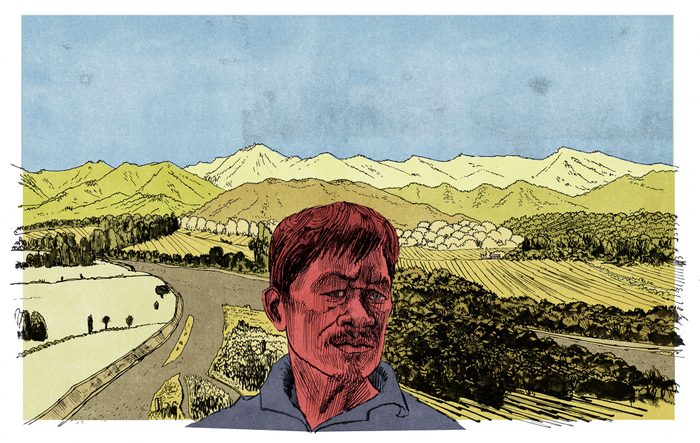
In October 2023, at the peak of Ifugao’s harvest season, IPM’s former vice chair, an indigenous farmer named Dick, drove his powder-blue van through five villages in and around Lagawe, trying to once again rally opposition to the Alimit Hydropower Project that, five years prior, had torn his community apart. For two days — over cups of instant coffee and plates of steamed rice, from one house to the next — Dick explained how the dam, still in its planning stages, would displace their community, submerge their farms and divert their water. He warned that the benefits the company promised — to build roads, provide free electricity and relocate locals to better land — would never arrive.
“Aboitiz came only to persuade us and when they have done their purpose, they will leave and we will suffer,” says Marceline Wagdang, a member of the community group Hapiyo, which Dick and other community members formed in 2020 as IPM’s successor to fight the hydropower project. “Money is powerful — it can kill people.”
Wagdang’s village, Olilicon, a community of just under 500 people, is divided over the project, but some of her neighbors, including the local elected official, publicly support it. Wagdang cannot see any benefit. Rice, a staple grown by many who rely on the river, is expensive to buy from the store. Growing food keeps them alive. The hydropower project threatens to starve them. To the ire of the village official, Wagdang collected 70 signatures on a petition against the dam. She was mobilizing her community alone and at times was threatened — once, even by her nephew, who warned, “Just see if nothing bad happens to you.”
Since Lee was shot, the military has had a quieter presence in Lagawe, though it’s still active in Ifugao. After Hapiyo began circulating its petition, Dick noted, a police operation took place in a neighboring village. In a region that’s long endured state terror, it doesn’t seem coincidental.
Over the past few years, the 5th Infantry Division has carried out indiscriminate aerial bombings across the Cordillera, purportedly targeting the NPA. Red-tagging has also continued, along with groundless claims and military attacks. This past fall, as Dick canvassed his neighbors, a farmer from another Cordillera province, Antonio Diwayan, was shot and killed by members of the 5th Infantry Division. The division claimed Diwayan — an elderly man known in his community as a small-scale miner and farmer — was an NPA member who had been killed in an armed encounter. The day Diwayan was killed, the division posted a blurred photo on its Facebook page of a rifle laying beside the dead body of an unidentified “NPA member.”
“It’s really difficult, even for us, to understand why farmers … end up victims of military combat operations,” says Audrey Beltran, vice chair of the Cordillera Human Rights Alliance. “Diwayan’s case is indicative of how state policies look at the value of innocent civilians.”
Around the same time, environmental activists Jhed Tamano and Jonila Castro were abducted and interrogated for nearly three weeks by suspected members of the 70th Infantry Battalion, part of the 7th Infantry Division in Luzon. Under threat and coercion, they signed an affidavit “confirming” they were NPA members. But at a government press conference after their release, the pair refused to lie and spoke out about the state’s role in their disappearance. They now face “grave oral defamation” charges filed by the Philippine Department of Justice.
Even human rights organizations — those who defend the defenders — have been recently targeted, says Beltran. In 2023, the Anti-Terrorism Council — a government body appointed by Duterte that has escalated red-tagging and streamlined the arrest of Philippine activists — used a full page spread in the Manila Times to label four staff members of the human rights network Cordillera Peoples Alliance as terrorists. In May, military personnel distributed flyers across Kalinga, proclaiming that Cordillera Human Rights Alliance and Cordillera Peoples Alliance are NPA.
Also in May, the Philippine Supreme Court issued a landmark ruling declaring red-tagging a threat to people’s “right to life, liberty and security” — a decision welcomed by human rights and environmental organizations. President Marcos has not yet endorsed the decision or adopted measures to criminalize the practice, but recent comments suggest he’s unlikely to support investigations of his own government.
Despite the near certainty of retaliation, in October 2023, after Dick had driven from village to village, some 50 people gathered in a corner of Ifugao for a Hapiyo general assembly. Even if the project had stalled, they knew the threat from this dam or another would remain.
“I will not stop organizing,” says Dick, “until I physically can no longer.”
In an email statement, SN Aboitiz Power said they had spent four years engaging with indigenous and local leaders, responding to project opposition and eventually securing the approval of four indigenous communities. The project was put on hold due to the pandemic and is now being reviewed to consider an additional component.
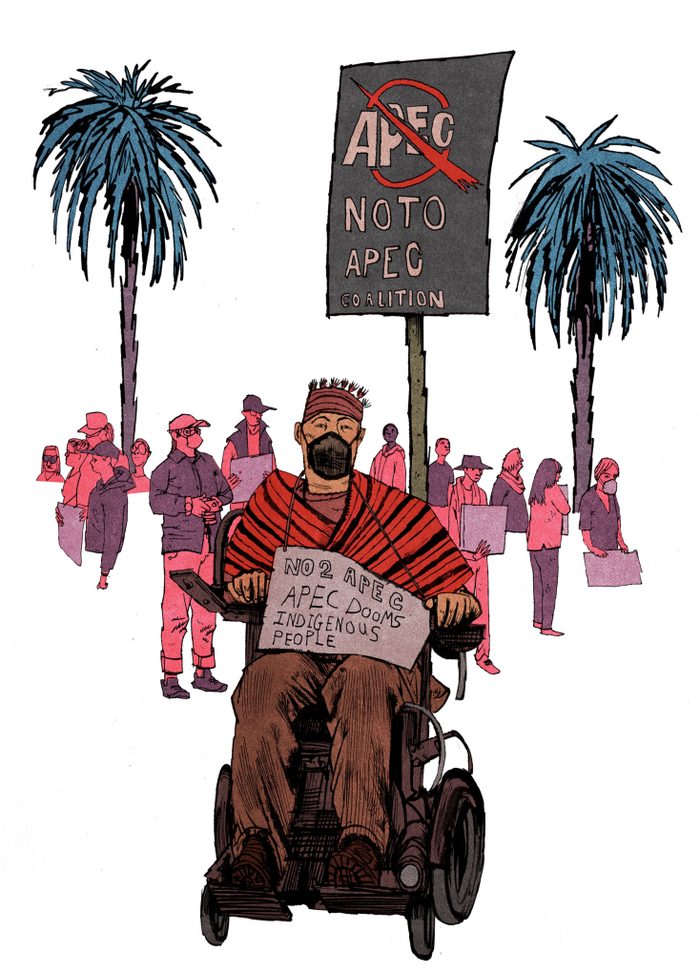
A month later and an ocean away, in San Francisco, Lee joined protests against the Asia-Pacific Economic Cooperation forum, a free trade conference that had brought Marcos to the United States. In 2015, soon after returning to IPM, Lee had stood beside his comrades to protest the forum in Manila. Eight years later, steering a motorized wheelchair down Market Street, a red Ifugao cloth draped over his shoulders, Lee was again on the front line. Though Lee speaks more slowly now, he has regained his voice — a fact he doesn’t take for granted.
“There are thousands who were extrajudicially killed before me, and they can no longer speak out,” said Lee. “There are those who were abducted, the communities being bombed and militarized. They can’t speak out. So with whatever platform I can, even if it’s just me sharing what’s happening there, I will continue to do it.”
This article was supported by the Leonard C. Goodman Institute for Investigative Reporting.
Fact-checking provided by Aaliyah Berryman, Thomas Birmingham and Joyce Li.
